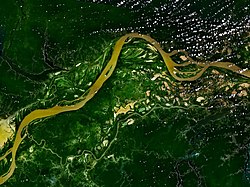User:Interiot/Main
Core topics collaboration The Core Topics Collaboration works to improve essential Wikipedia topics. The current collaboration is Amazon rainforest. The Amazon Rainforest (Brazilian Portuguese: Floresta Amazônica or Amazônia; Spanish: Selva Amazónica or Amazonía) is a moist broadleaf forest in the Amazon Basin of South America. The area, also known as Amazonia, the Amazon jungle or the Amazon Basin, encompasses seven million square kilometers (1.7 billion acres), though the forest itself occupies some 5.5 million square kilometers (1.4 billion acres), located within nine nations: Brazil (with 60 percent of the rainforest), Peru (with 13 percent of the rainforest, second after Brazil), Colombia, Venezuela, Ecuador, Bolivia, Guyana, Suriname, and French Guiana. States or departments in four nations bear the name Amazonas after it. The Amazon represents over half of the planet's remaining rainforests and comprises the largest and most species-rich tract of tropical rainforest in the world. You can help pick the next Core Topic collaboration article. |
| Though this project is inactive, you can help with : Dan Sullivan (musician) (random unreferenced BLP of the day for 4 May 2025 - provided by User:AnomieBOT/RandomPage via WP:RANDUNREF). |

|
The ongoing maintenance collaboration is the backlog of articles to have bot-modified external links checked. We need your help to completely eliminate this backlog in the coming weeks. |
You can help improve the articles listed below! This list updates frequently, so check back here for more tasks to try. (See Wikipedia:Maintenance or the Task Center for further information.)
Help counter systemic bias by creating new articles on important women.
Help improve popular pages, especially those of low quality.
Today's featured articleHualca Hualca is a 6,025-metre-high (19,767 ft) extinct volcano in the Andes of southern Peru. It is part of the Peruvian segment of the Central Volcanic Zone, one of several volcanic belts in the Andes. It lies about 70 kilometres (43 mi) northwest of Arequipa and is part of a north–south chain that includes the volcanoes Ampato and Sabancaya, the last of which has been historically active. Hualca Hualca features a wide amphitheatre-like structure on the northern flank, which was created by a gigantic landslide during the Pleistocene. After the collapse, renewed volcanic activity built a new summit and several lava dome complexes within the collapse scar. After the cessation of volcanic activity, glaciers eroded the volcano and formed multiple moraines. The present-day volcano is covered by glaciers, and during the Last Glacial Maximum, glaciers advanced to low altitudes. There are hot springs and geysers north of the mountain, and the magma chambers of Sabancaya are located below Hualca Hualca. (Full article...)
Recently featured:
|
In the news
|



